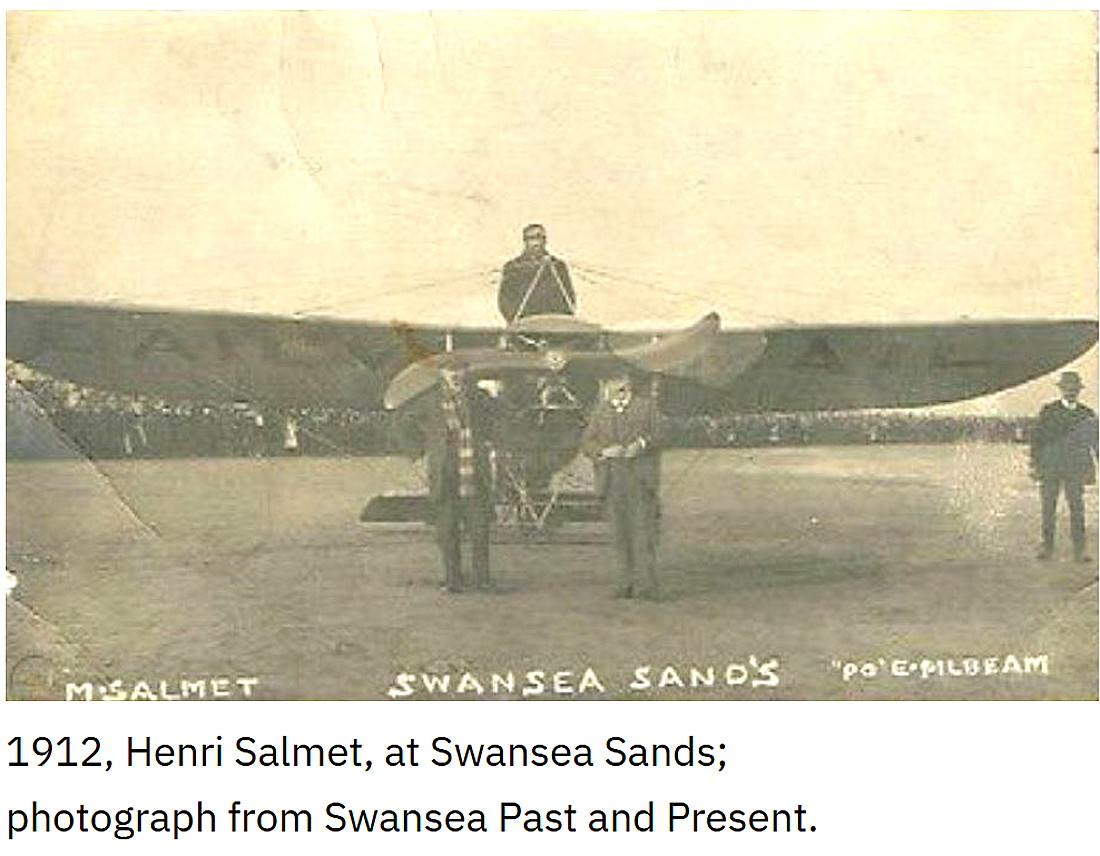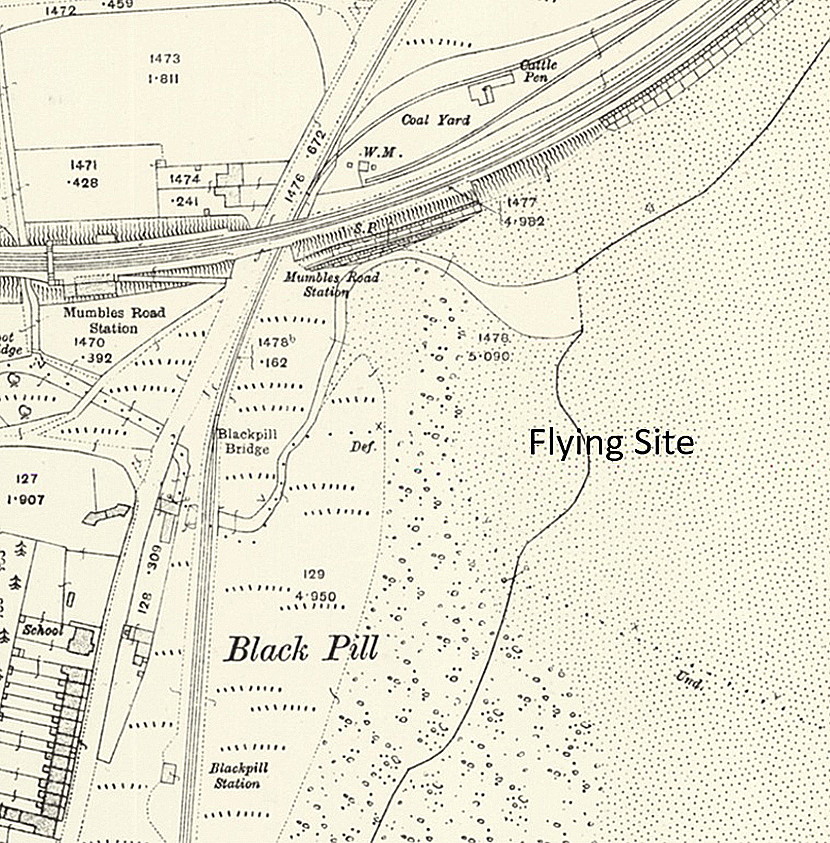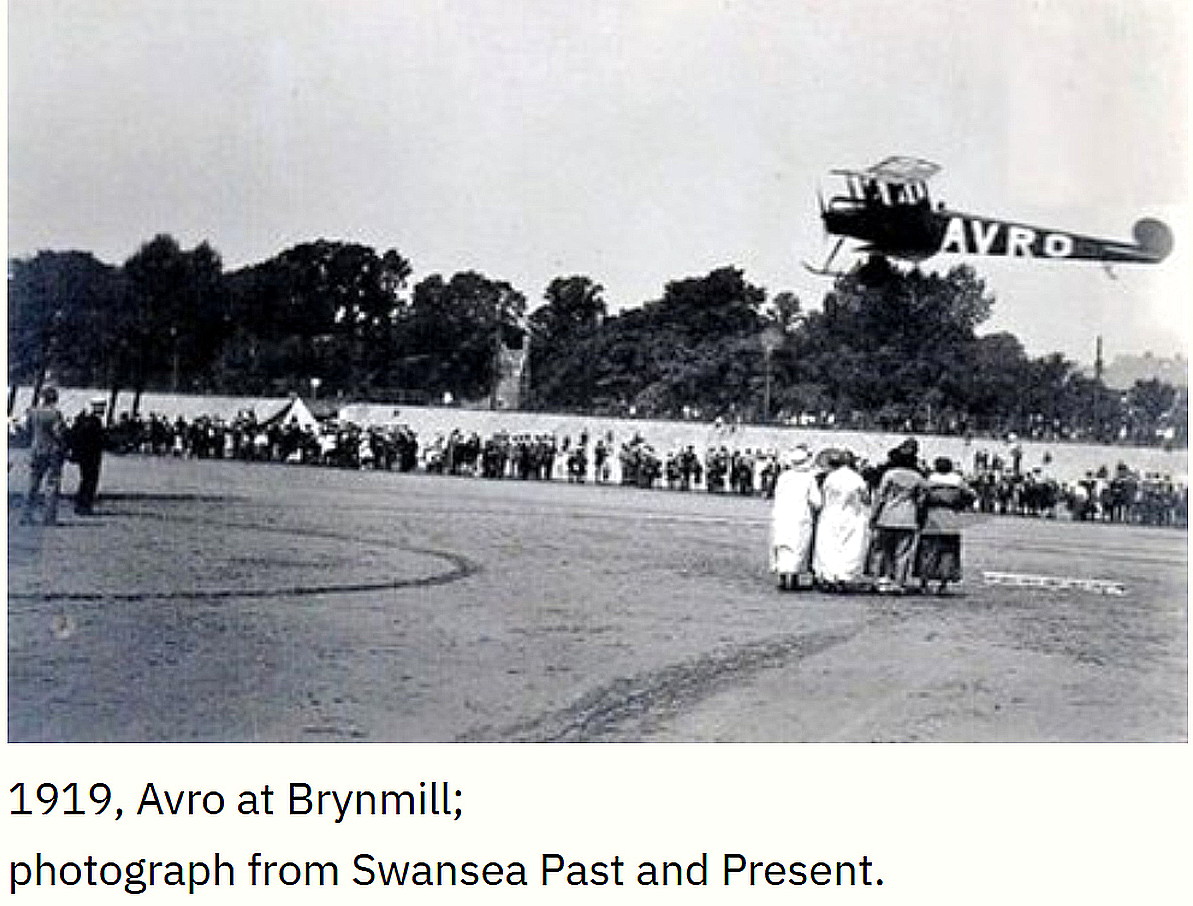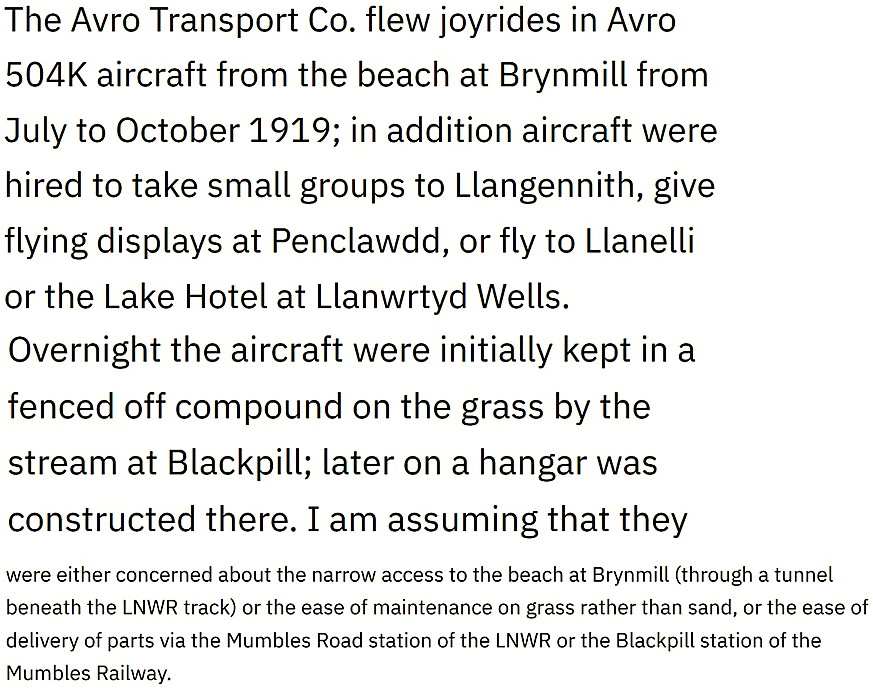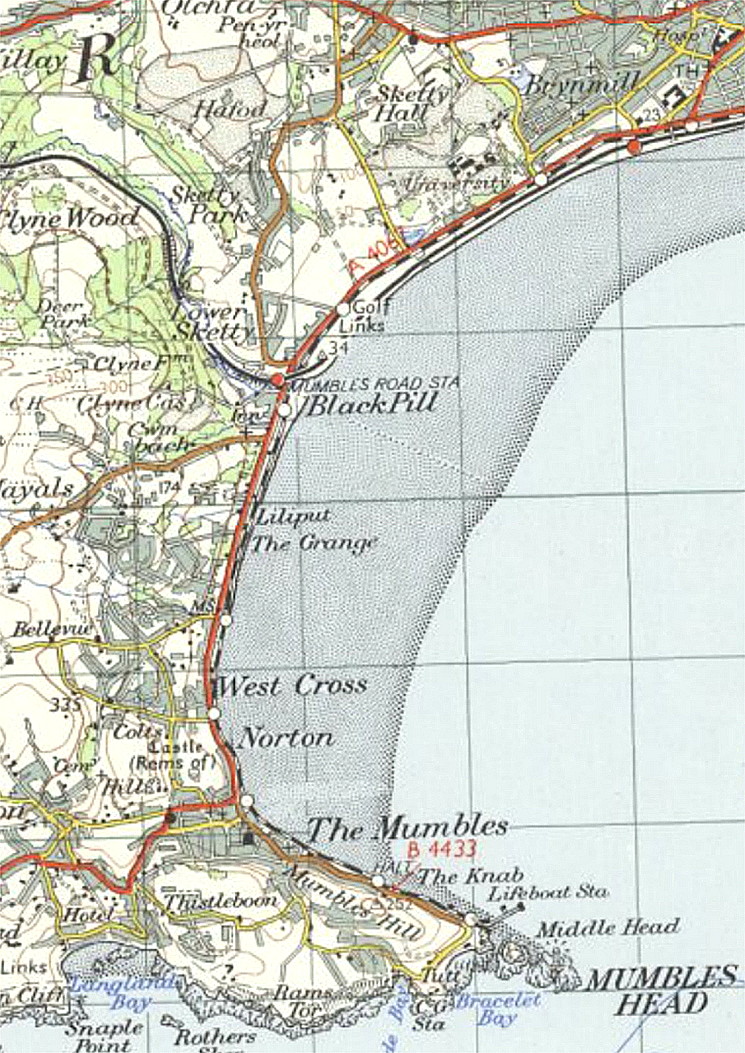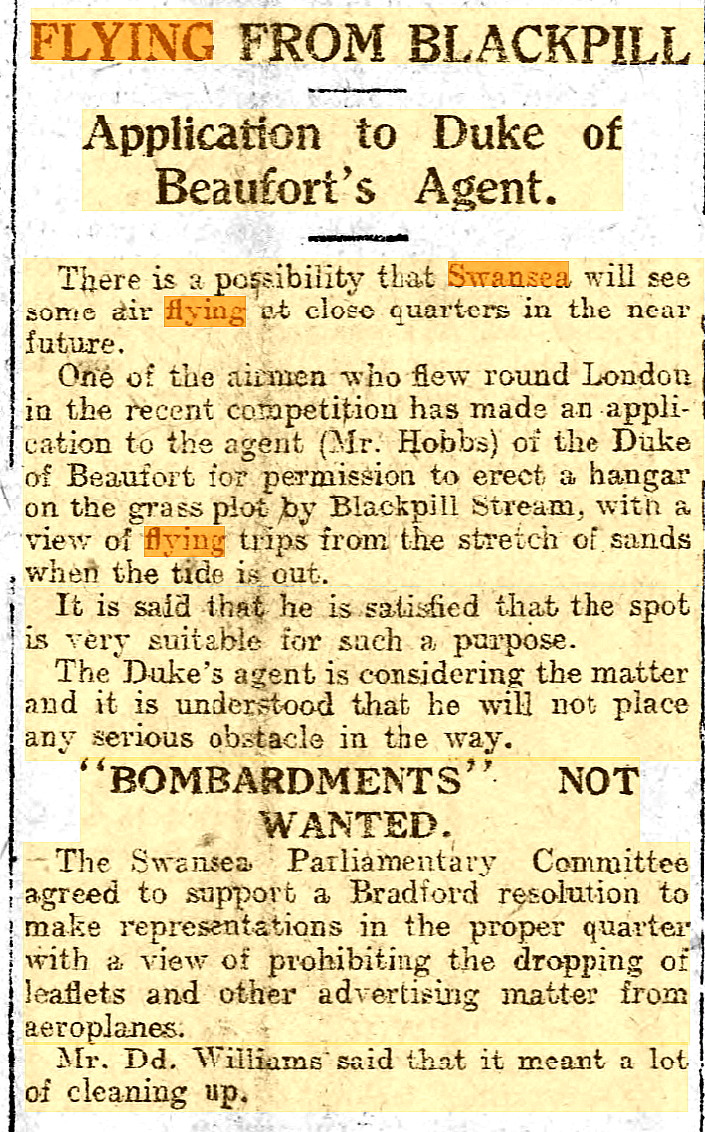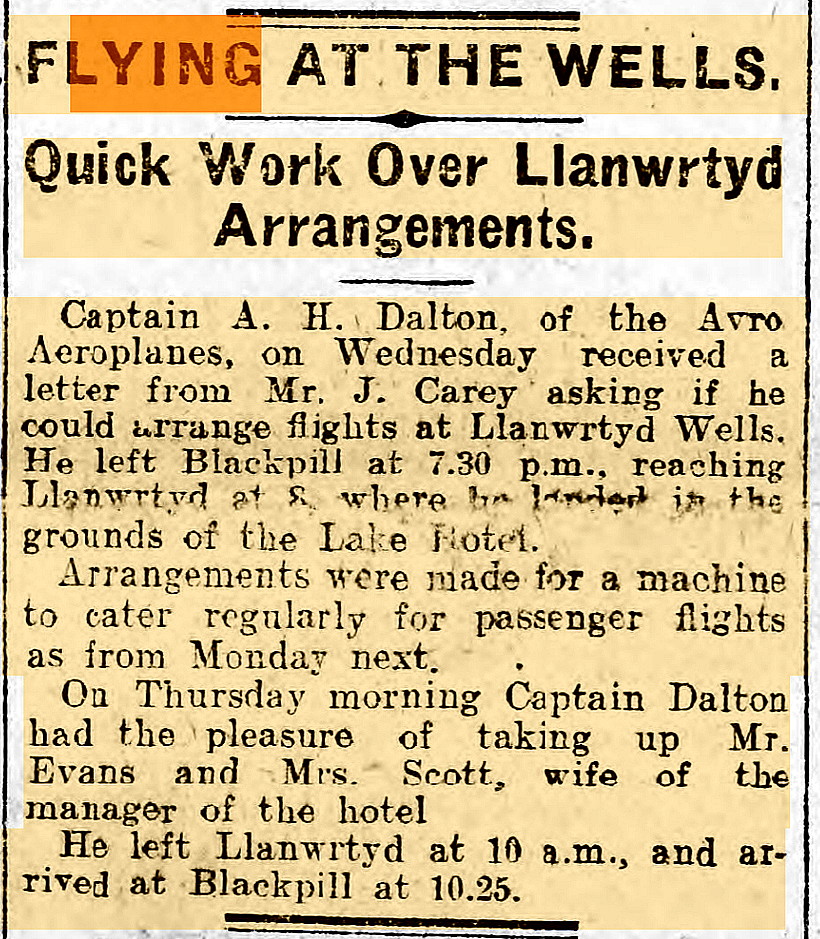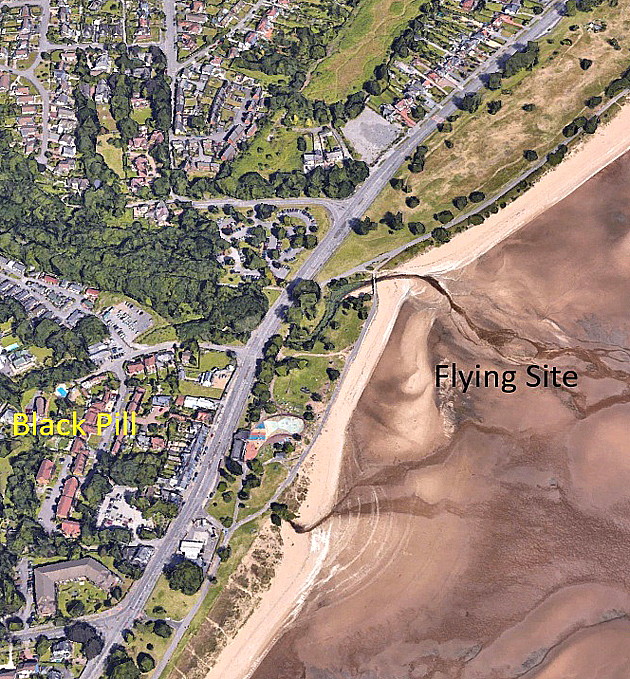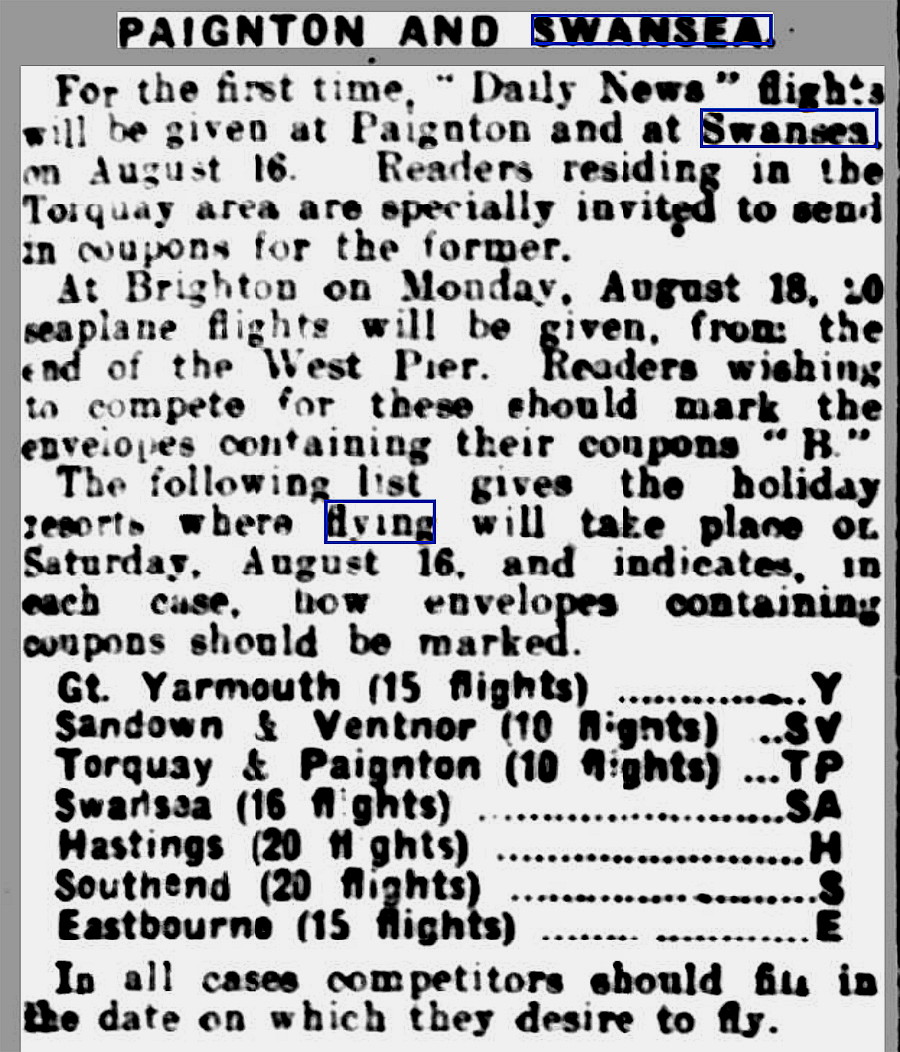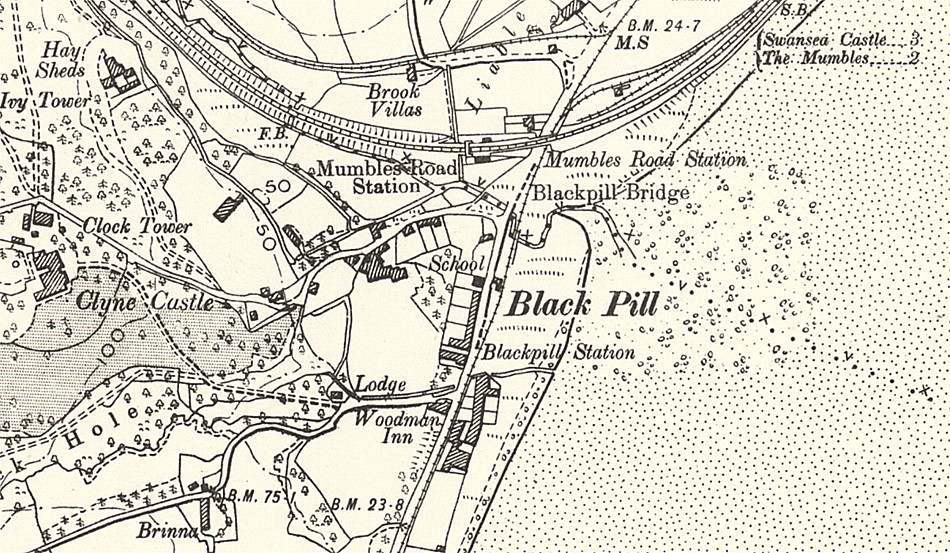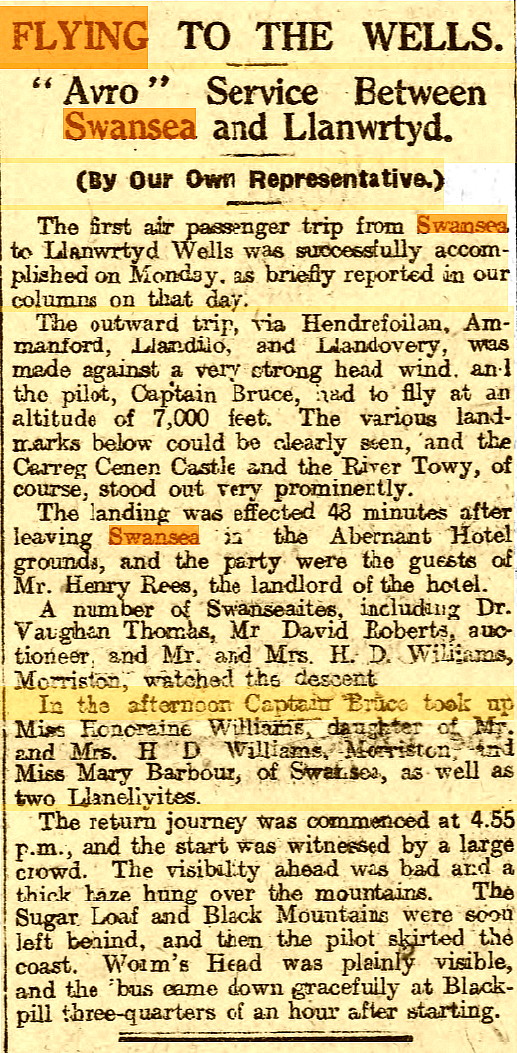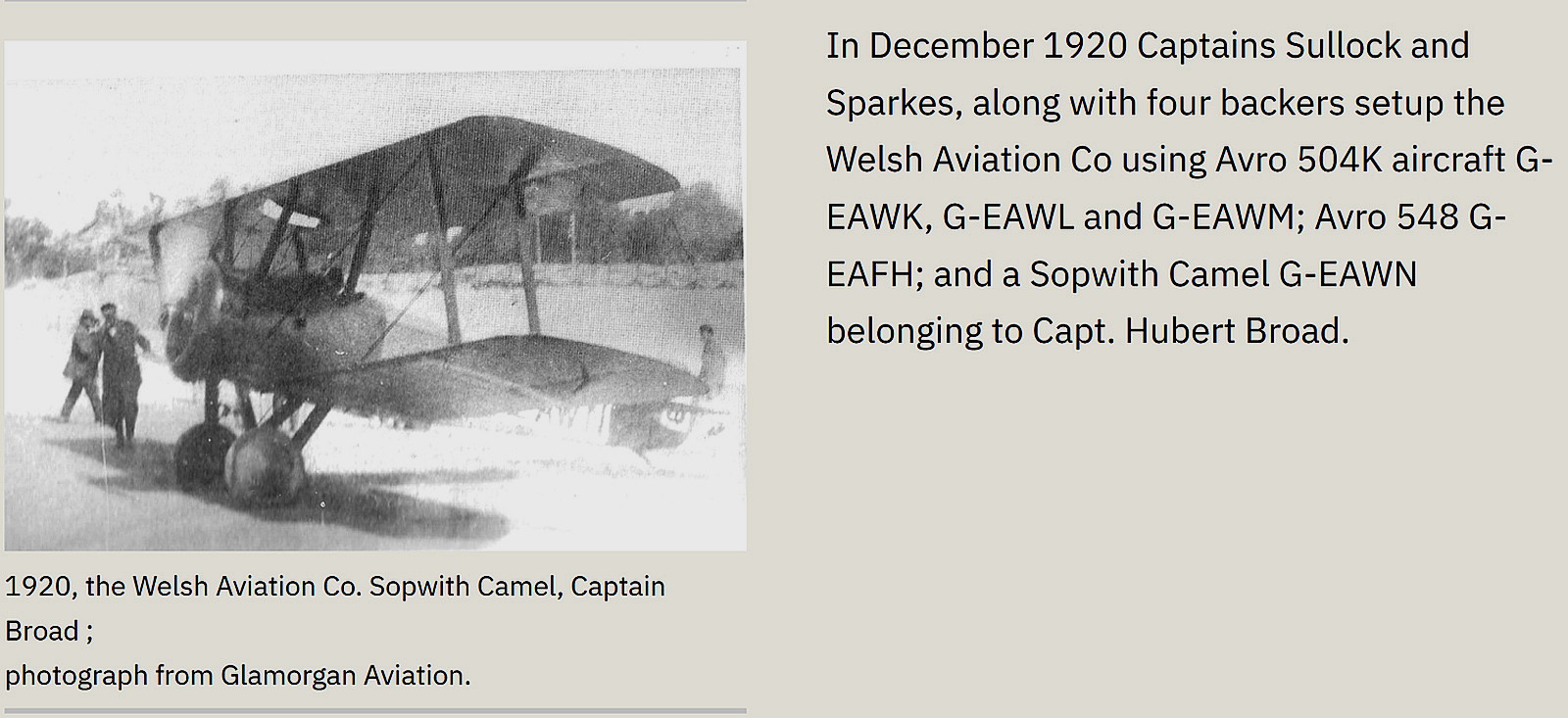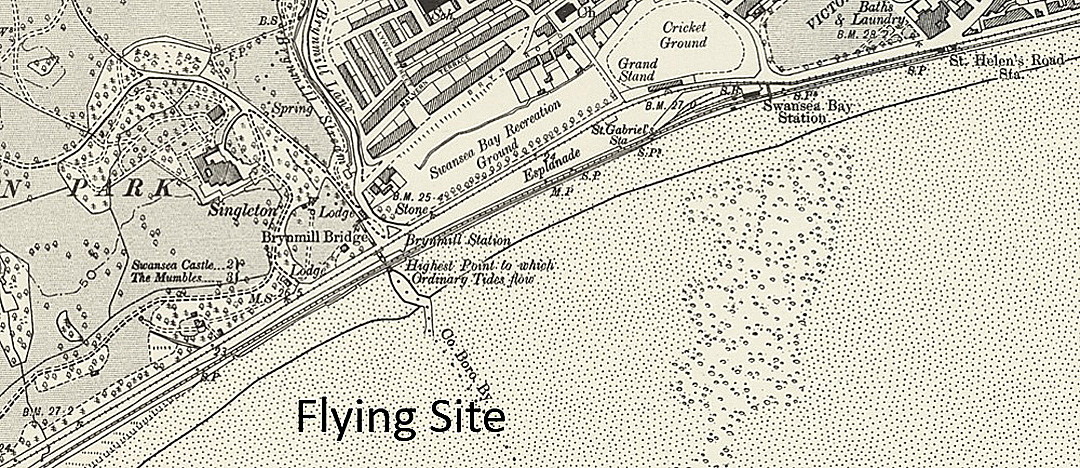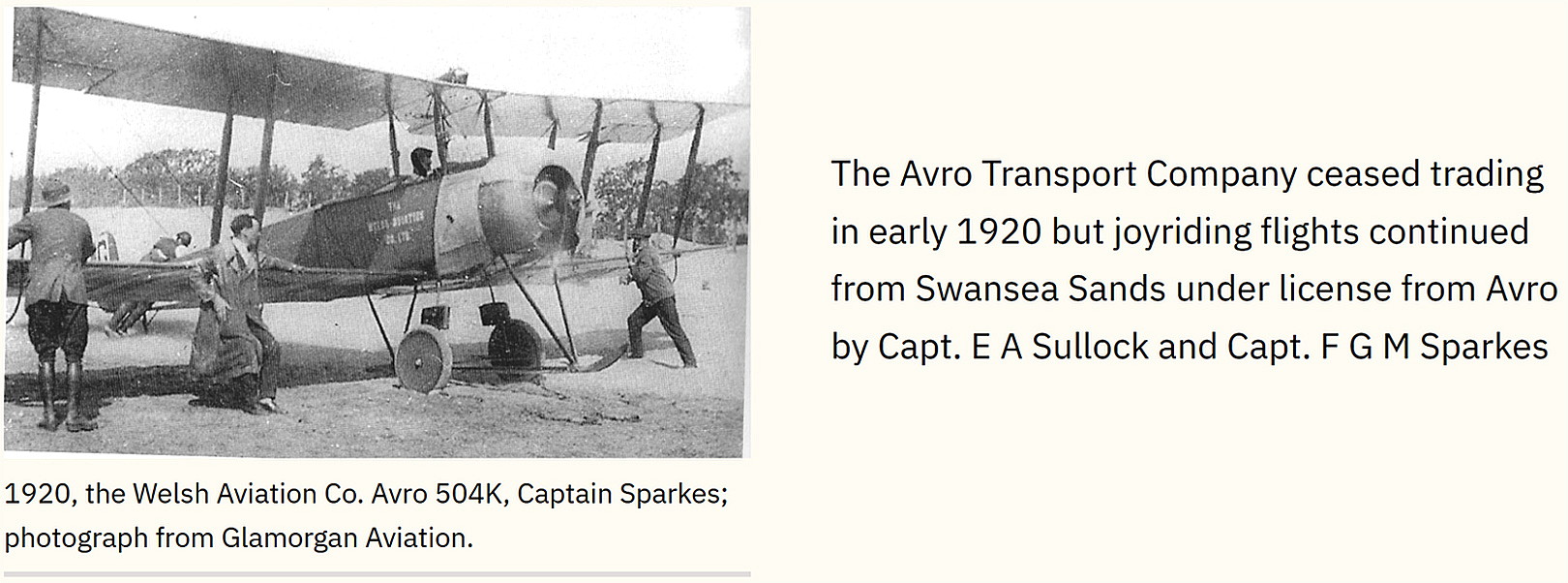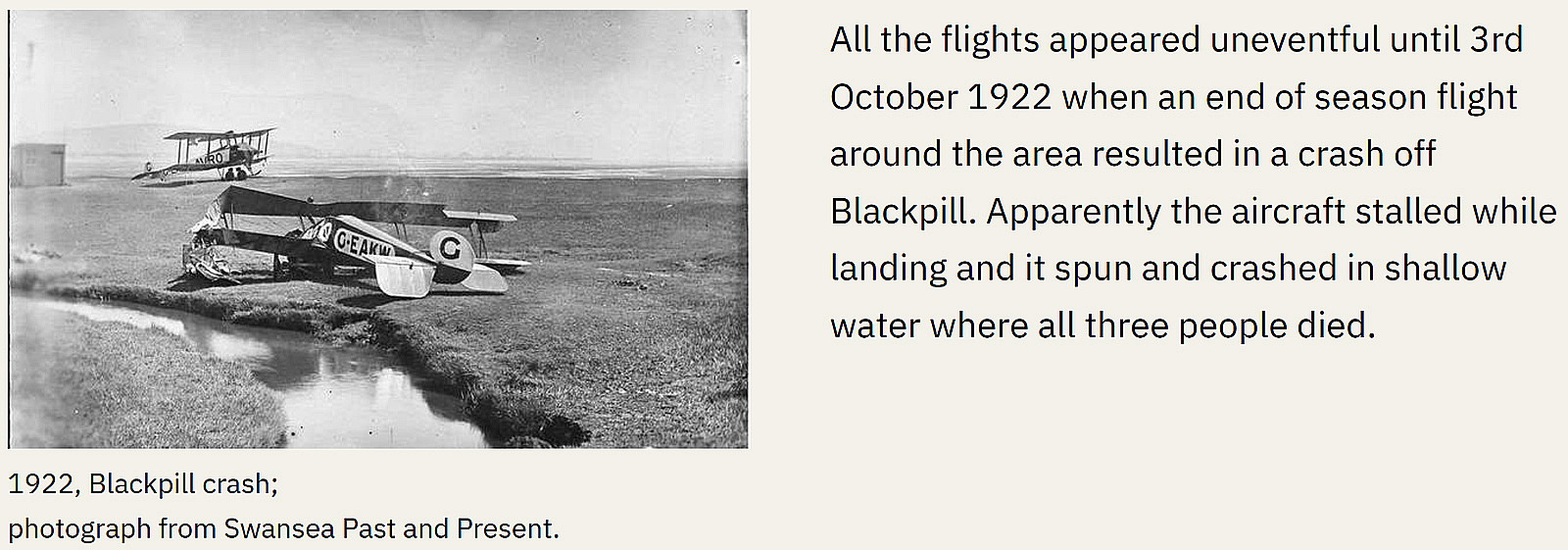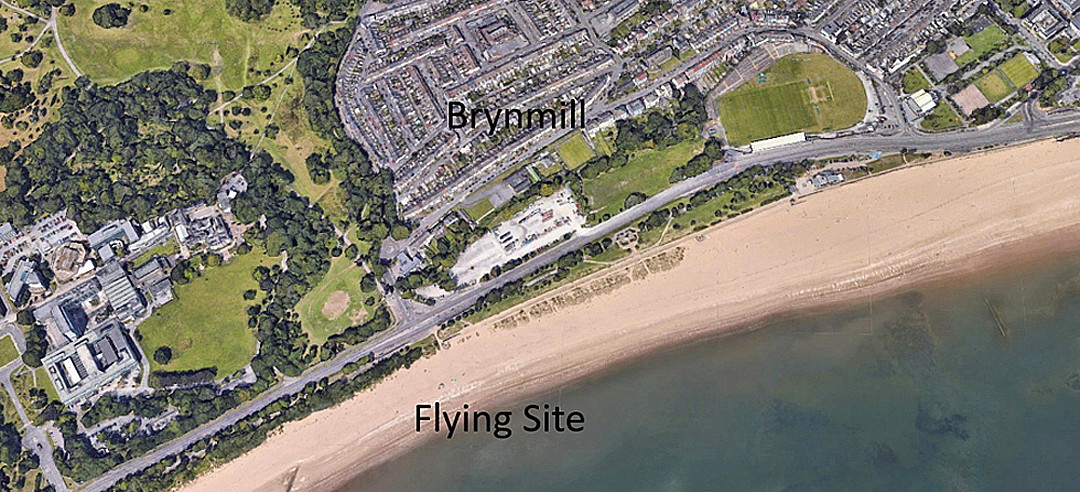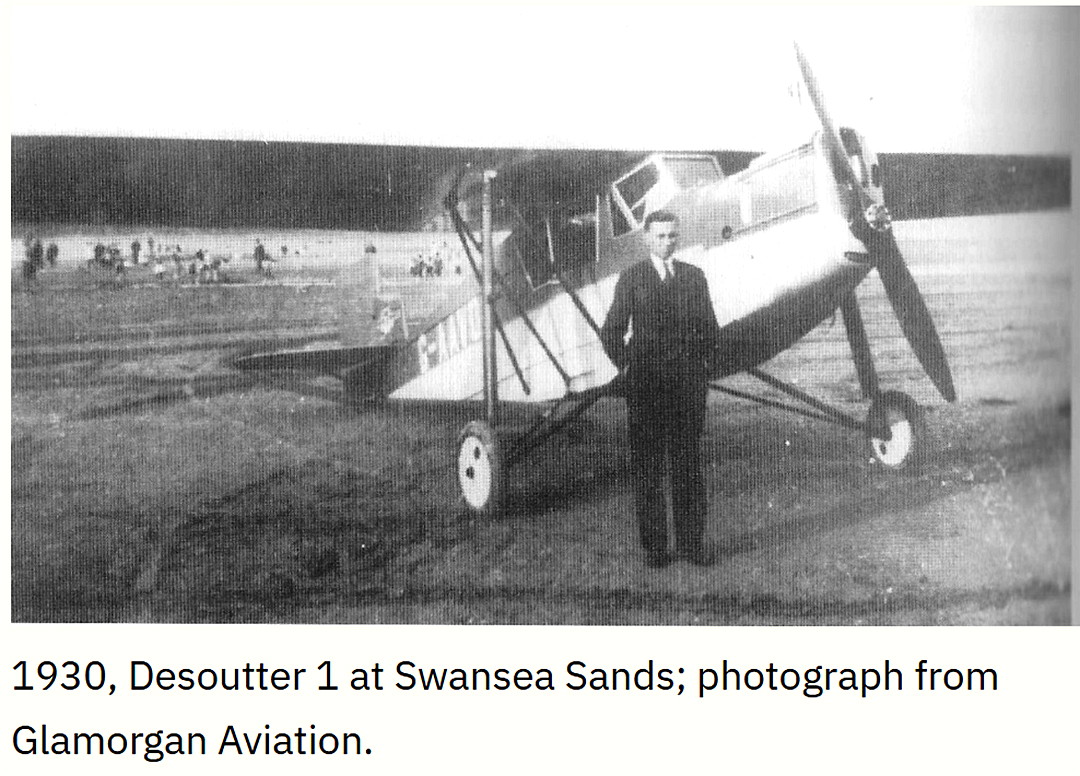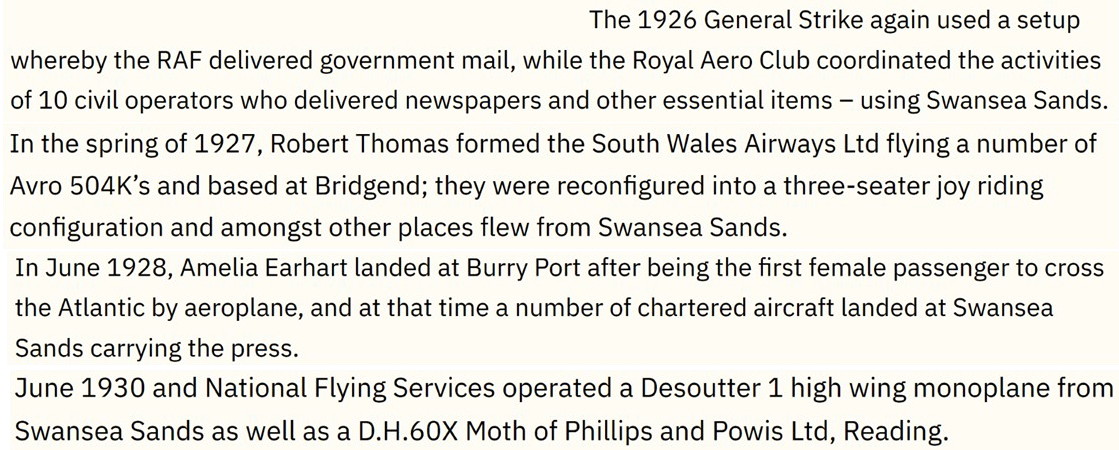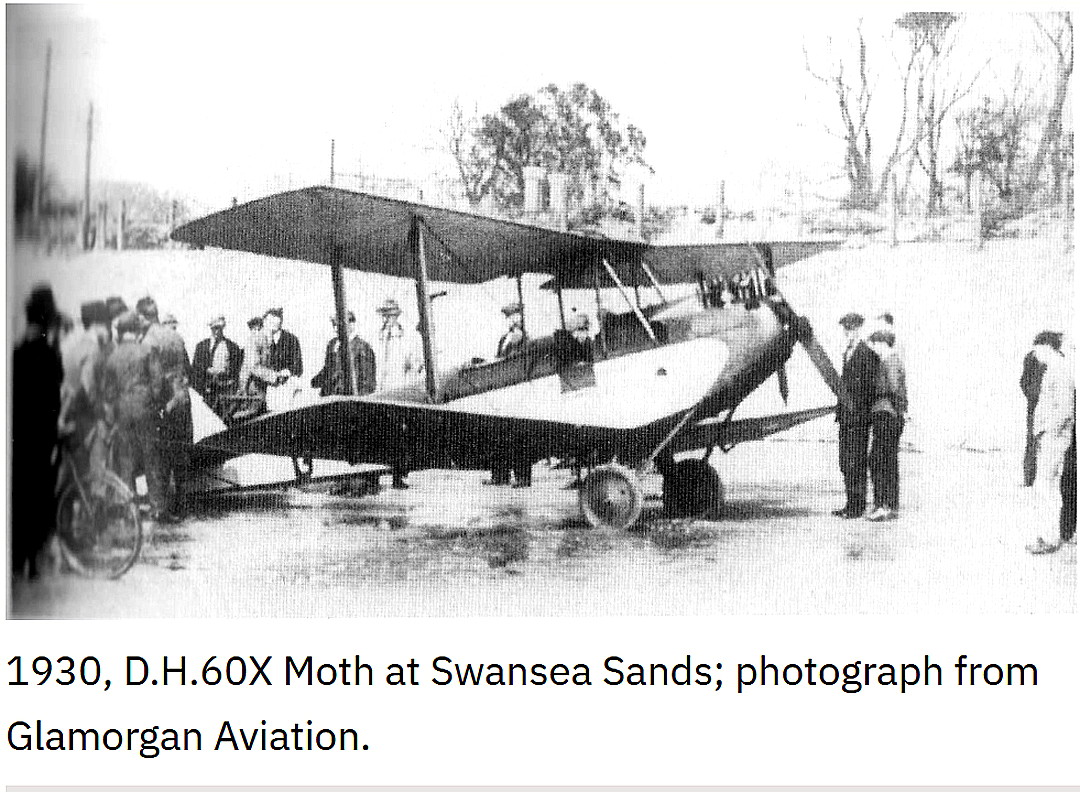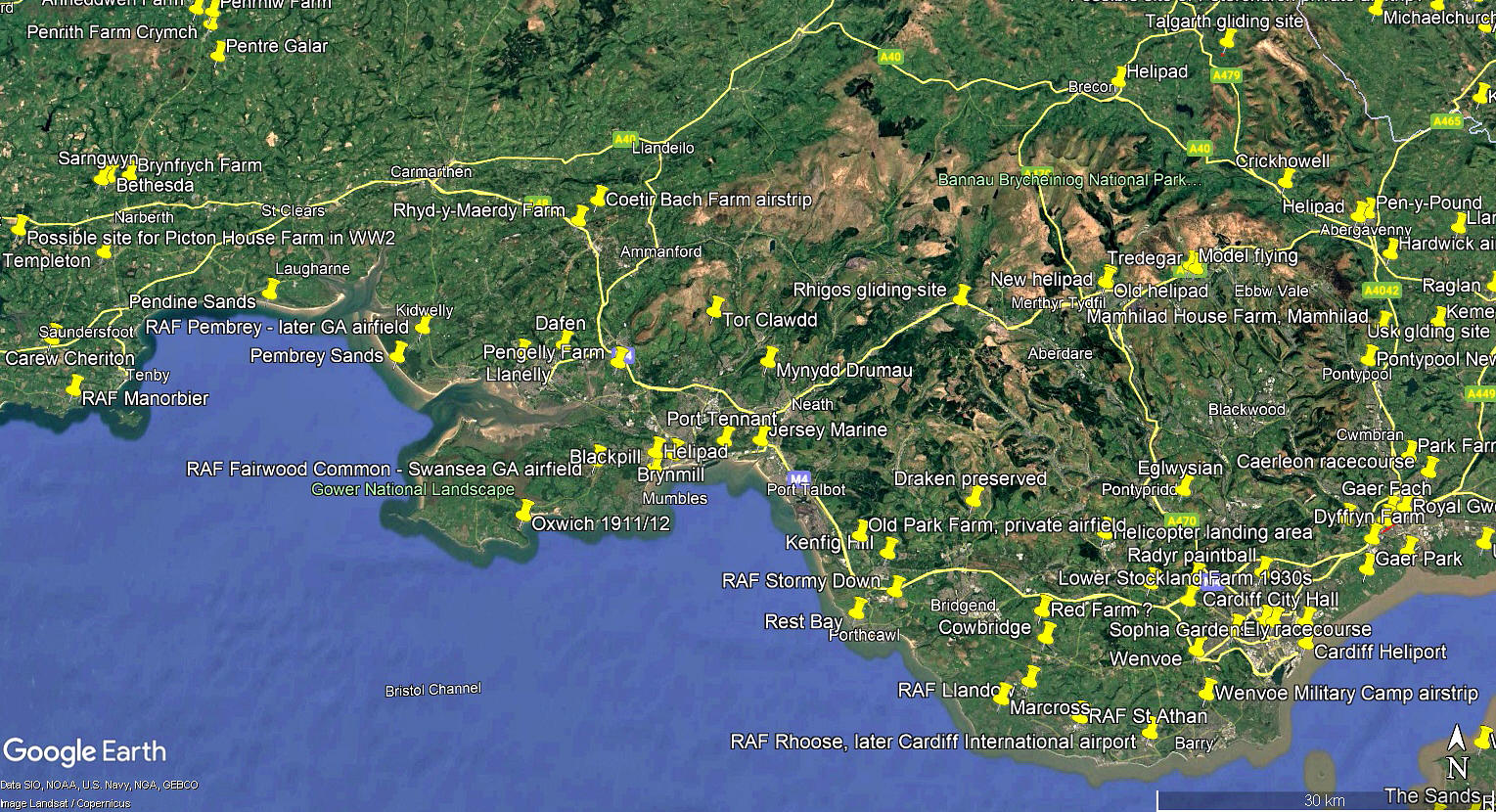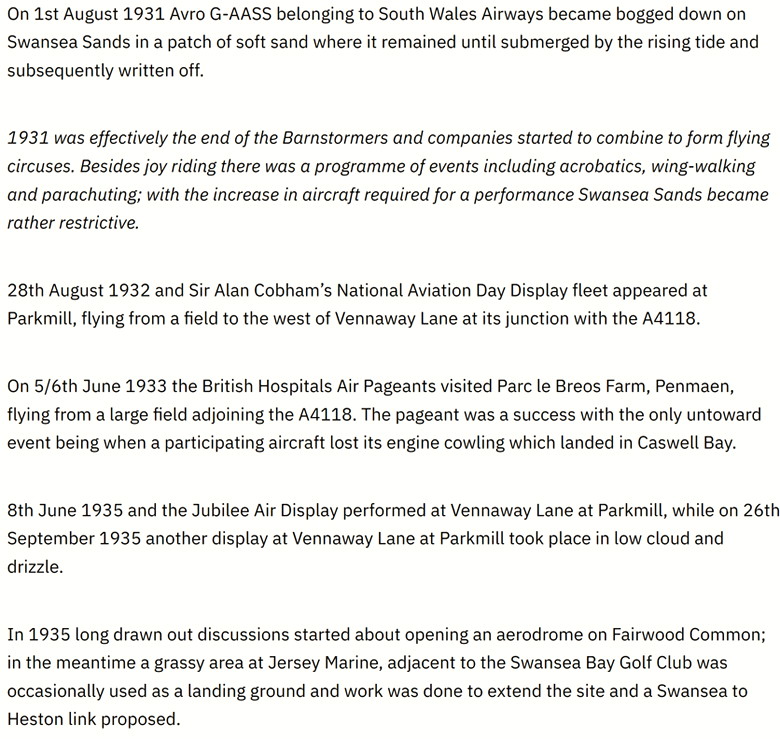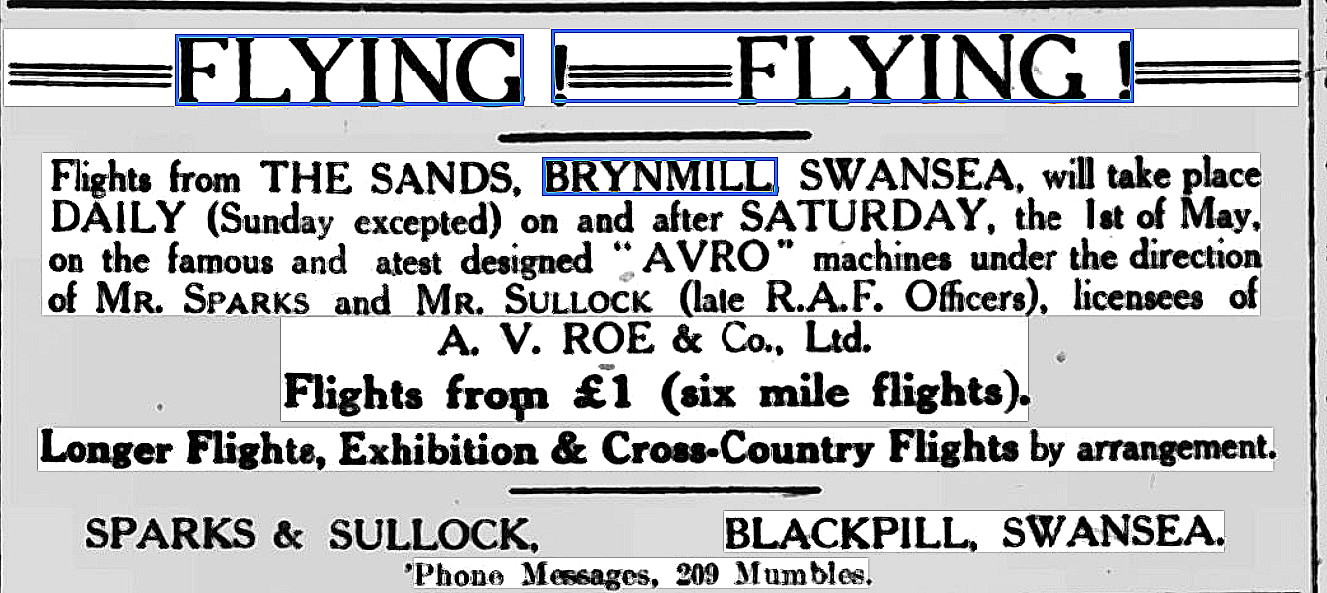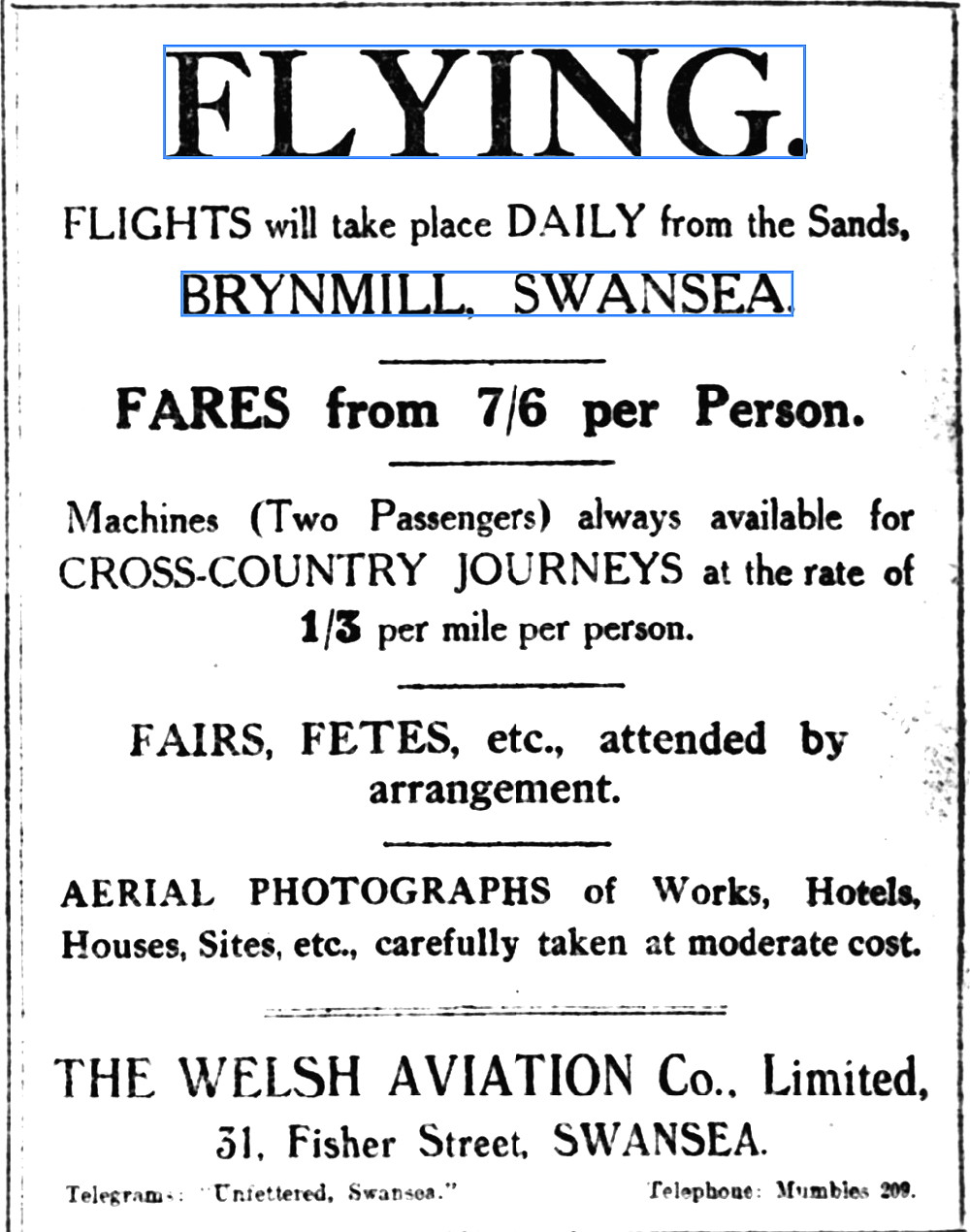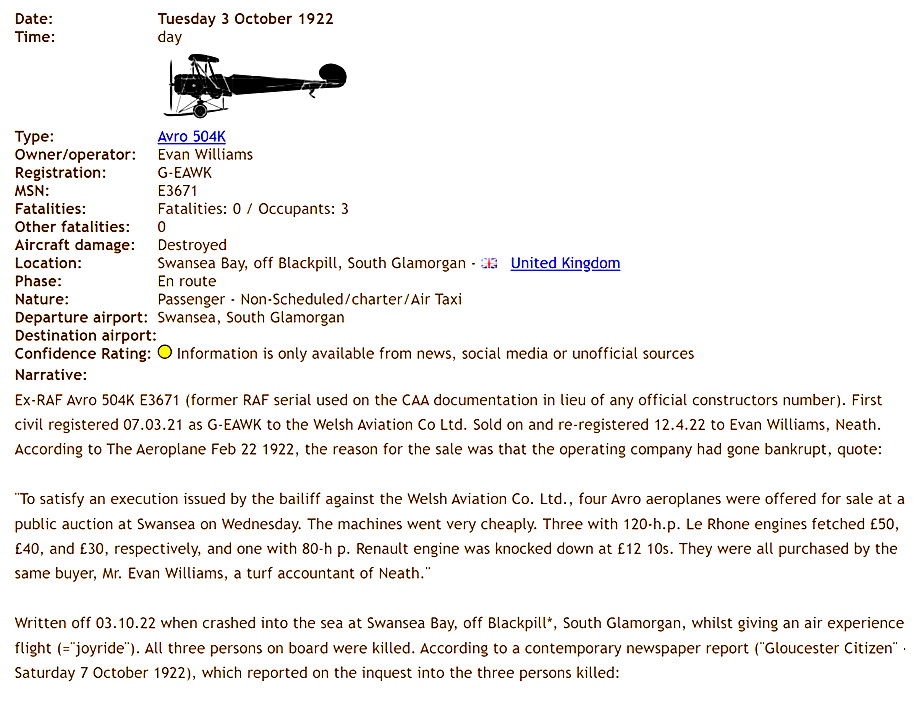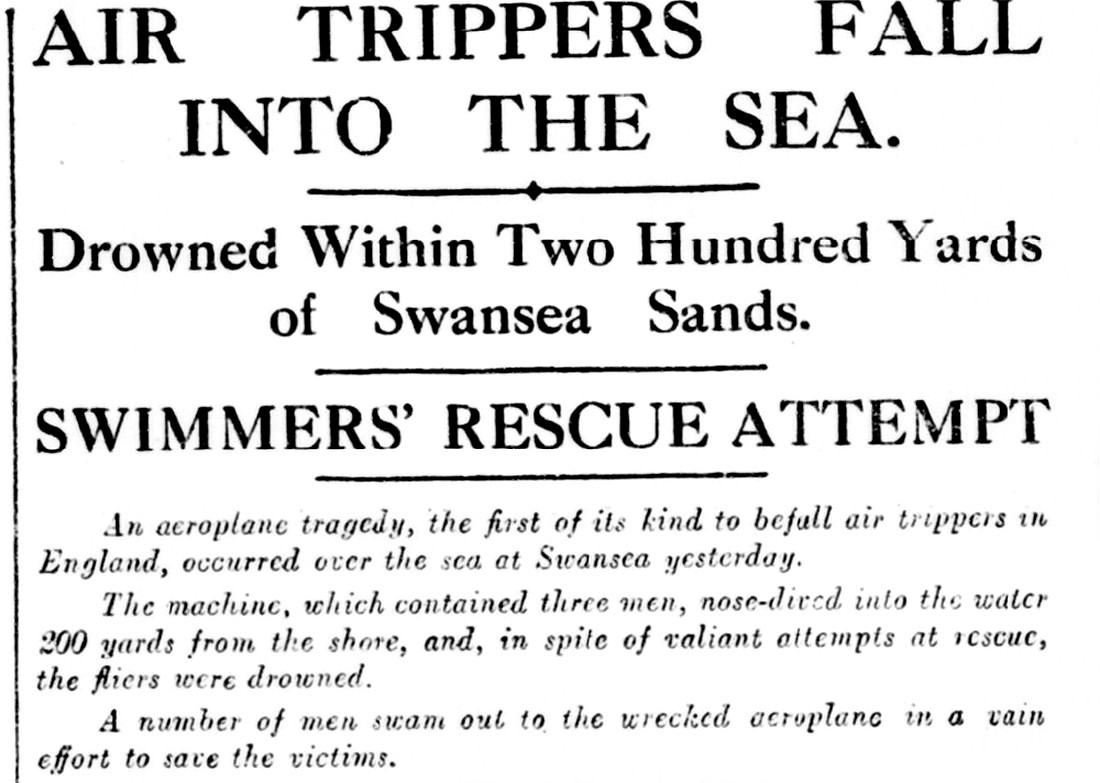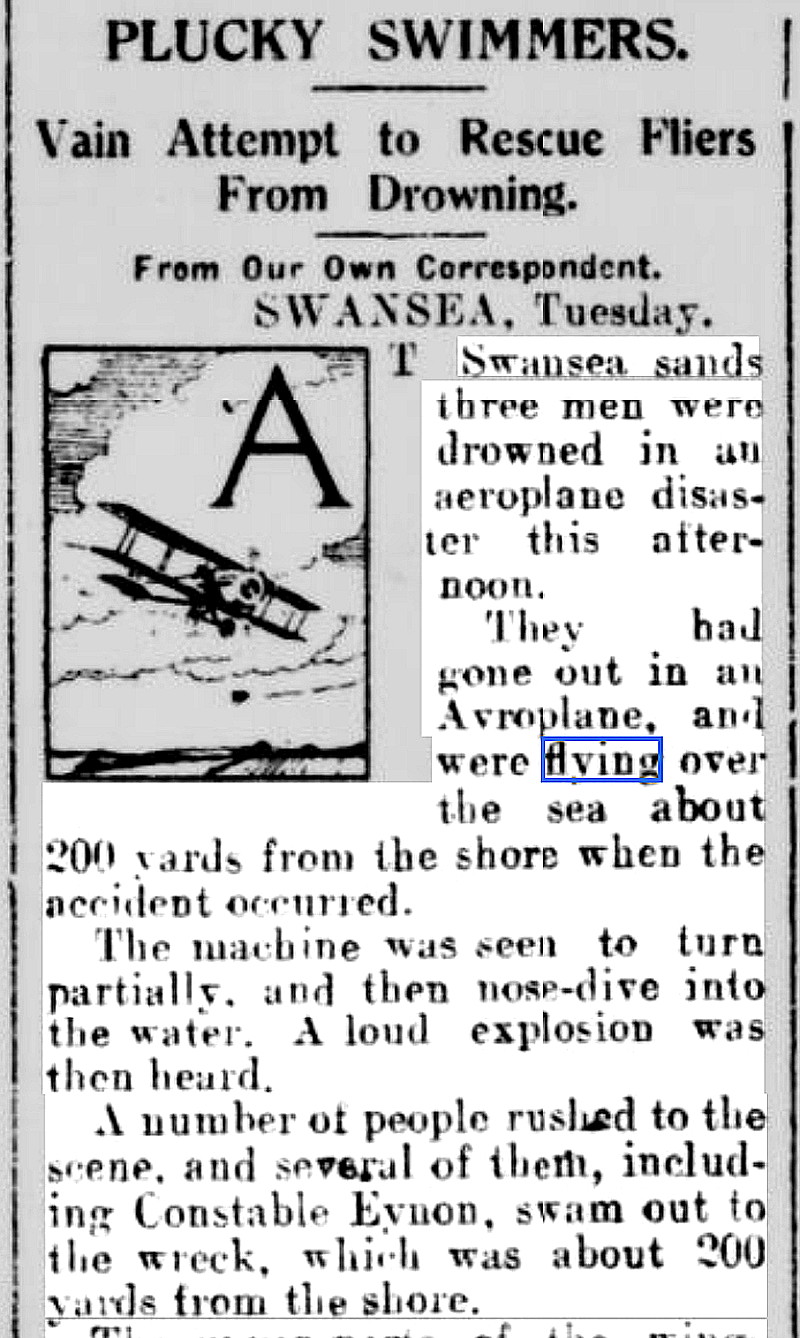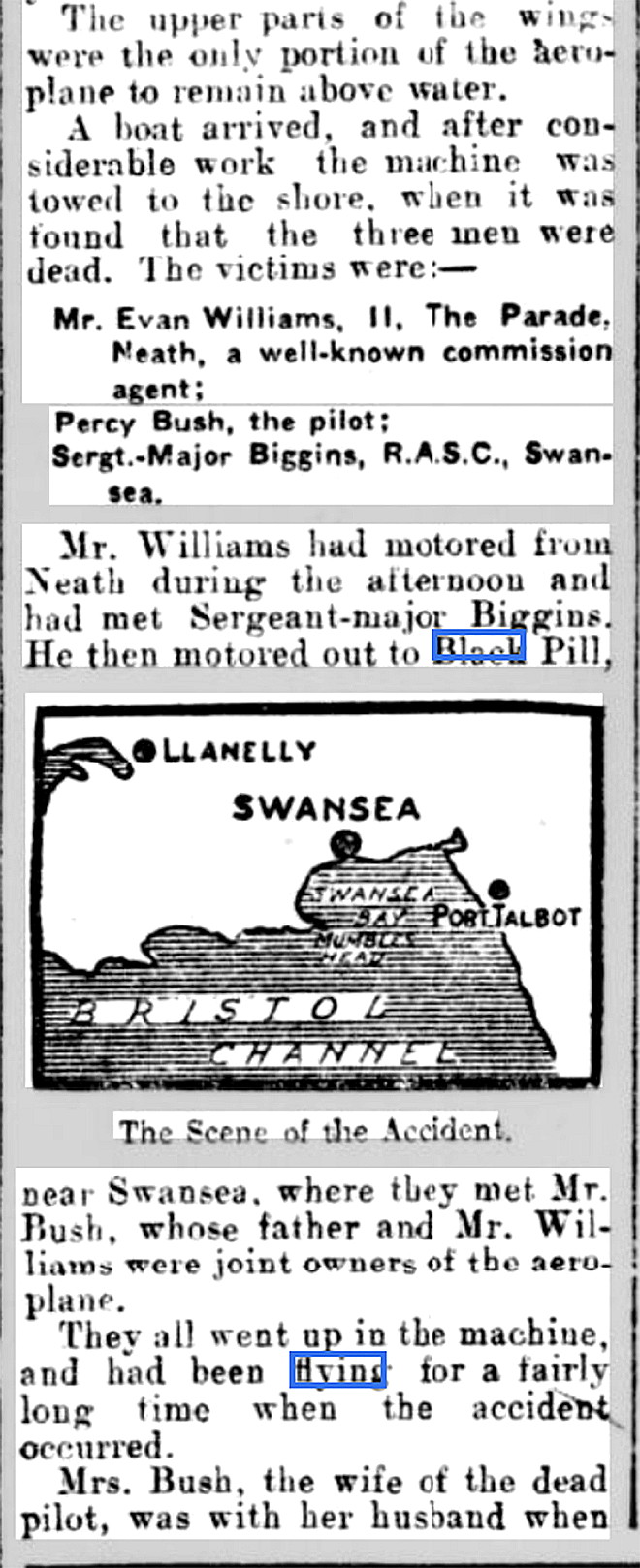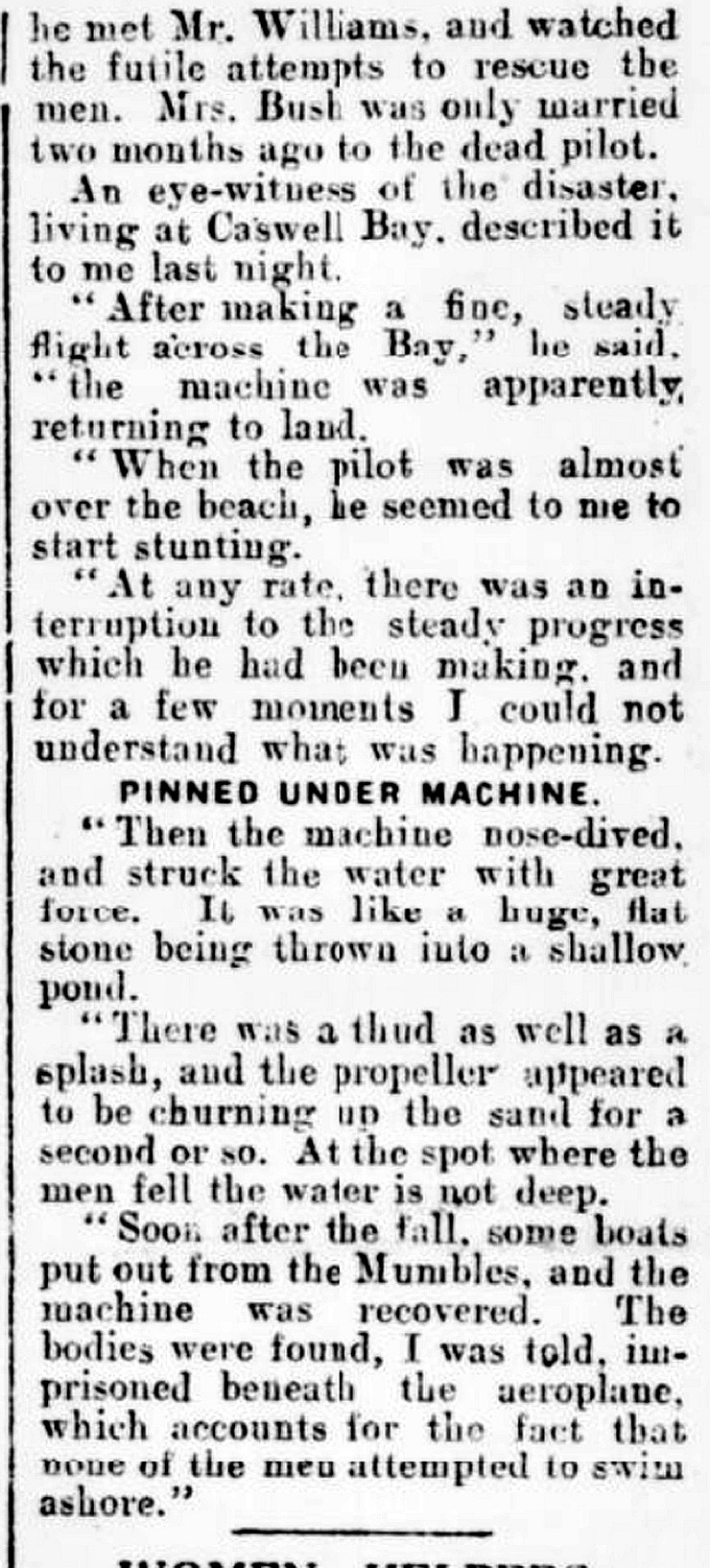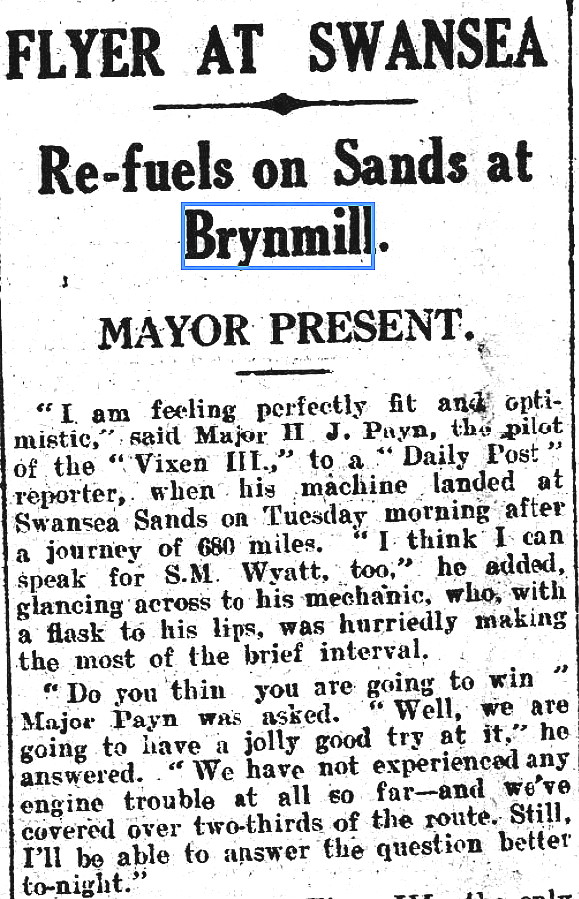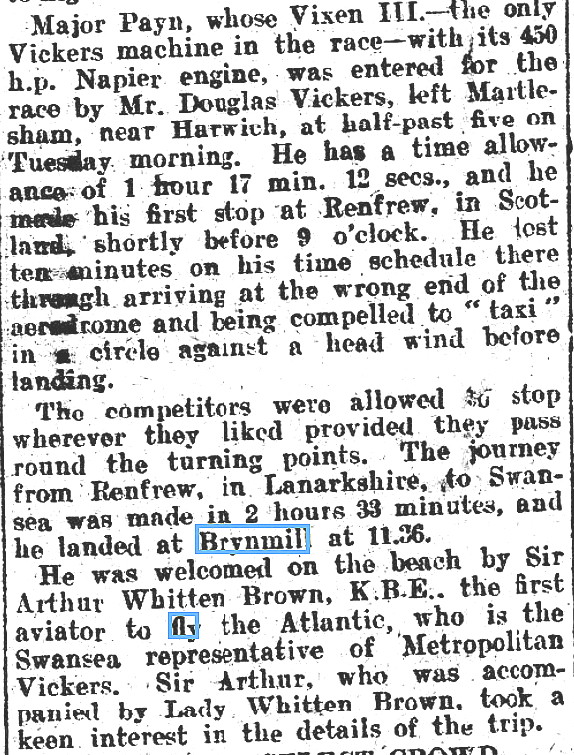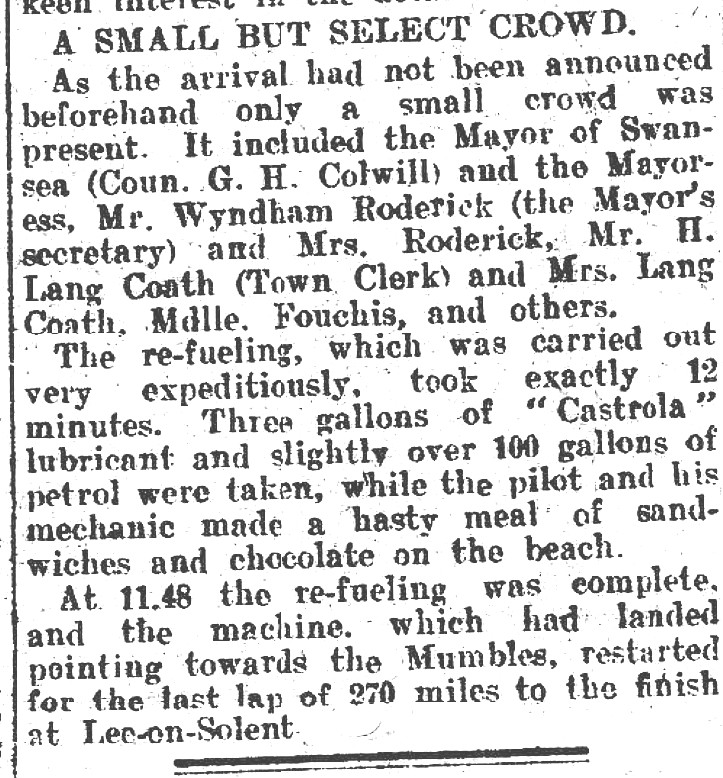Swansea Sands
SWANSEA SANDS: Beach aerodrome
This beach area to the south-west of Swansea city centre can probably best be divided into two main locations, BLACK PILL and BRYNMILL.
A MICHAEL T HOLDER GALLERY
In June 2025 I asked Mike Holder, a great friend of this 'Guide', if he could kindly take a look into this subject as I had found a reference to it. Have to say, I hardly expected this result!
THE FIRST FLYING VISITOR TO THE SANDS
The photo is from Swansea Past and Present. It appears that this was Henri Salmet, the then very famous French aviator, who was conducting a tour sponsored by the Daily Mail, and operating here, from the 24th to 25th May in 1912. Do please see a seperate listing for PORT TENNAT BOG for an account of his initial arrival location. What we don't know is where on the Sands he was operating from.
THE POST WW1 PERIOD
After WW1 there was a huge surplus of both aircraft and airmen, many keen to earn a living in aviation. Indeed, faced with possible ruin from lack of orders, the A V Roe company (Avro), set up both a big joy-riding operation, converting the rear cockpit of their 504 series to take two passengers, plus offering this conversion to potential customers. It appears that, possibly, the latter option was eventually, more attractive to Avro?
1919
Note that in Photo Two, (also from Swansea Past and Present), the aircraft does not carry a civilian registration. The requirement to do so came about from an International Air Navigation Convention which was implemented on the 22nd July 1919. British registrations starting with G-EAAA. However, many civil operators took their time before coming in-line to do so.
Article One is, once again, from Swansea Past and Present. Article Two was published in the South Wales Weekly Post on the 6th June 1919.
Article Three was published in the Cambria Daily Leader on the 7th August 1919.
The Notice appeared in the Daily News (London) on the 8th August 1919. Article Four was published in the South Wales Weekly Post on the 16th August 1919.
THE 1920s
Photo Three and Photo Four, (with captions) are both from Glamorgan Aviation.
This photo I found rather interesting, and I expect, certainly for others suffering from 'anoraky' tendencies. I can find no reference of G-EAKW (ex H2593) being registered to anybody in 1922. Indeed, in the official British register it was registered to the A V Roe (Avro) Co during 1919 and 1920, then no further entries. Plus, from other records, this registration was cancelled in September 1920. Some people tend to set great store on official records, but, I have discovered a few other anomolies over the last quarter of a century.
However, there is another possible explanation - has the photograph been 'touched up'? In which case it would seem that the person doing this, and probably not at all interested in aviation, has transposed the last two letters? Because G-EAWK (Ex E3671) was registered to E Williams, trading as Welsh Aviation Co, and flying from SWANSEA SANDS. And guess what - recorded as having crashed here 03.10.22. All the joys of course, involved in trying to produce a 'Guide' in the vain attempt of setting the record straight. The photo is from Swansea Past and Present. Any other ideas?
The excerpt One is also from Glamorgan Aviation.
THE 1930s
These three items are also from Glamorgan Aviation. Must admit that I really should resist doing this, but find the need to investigate many aspects highly addictive.
For example in the Excerpt Two it states that the Desoutter 1 (in Photo Six) was being operated by National Flying Services. However, according to official records, such as the British register, G-AAVO was registered to Philips & Powis Aircraft (Reading) from 26.06.30 until December 1936 wnen the registration was cancelled. As was the DH60X Moth it seems also registered to Philips & Powis.
These three pictures are from my Google Earth © derived database.
AND LASTLY?
This list was also obtained from Glamorgan Aviation. Was pleased to see that this 'Guide' does have these listed, (plus OXWICH BAY further along the Gower peninsular), but, with pretty limited info for PARKMILL and PARC le BREOS FARM. So, another future project.
UPDATE
Not long after finishing, (or so I thought!), this listing, Mike Holder decided to go back to the subject and put in some new search criteria. Lo and behold, up popped some new items, which cover three aspects.
TWO ADVERTS FOR 1920 & 1921
Both of these adverts appeared in the Western Mail. Advert One on the 3rd May 1920 and Advert Two on the 13th May 1921. Note how Advert Two, placed by The Welsh Aviation Co. Ltd, offers a range of services over and above 'joy-rides'.
THE CRASH OF THE AVRO 504K, G-EAWK, 3rd OCTOBER 1922
This report certainly provides the answer to my previous ponderings above! It also gives me enough information to be able to ascertain, without much if any doubt, what happened.
It is a classic case of situation that has claimed a great many lives, not just in the early days, but right up to the present day. Many fewer now.
When I was learning to fly avoiding this classic 'gotcha' was drummed into me, time and time again. Basically, especially at low speeds, do NOT greatly increase the bank angle unless applying considerable power and lowering the nose to increase speed. It is a situation mostly likely to occur when coming into land and turning onto finals, and, the worst thing you can do is to try and tighten the turn by pulling back on the stick at the same time.
At the risk of over-simplification, an increasing bank angle also increases the stall speed, and applying extra 'G' can easily very quickly make matters much, much worse - making the aircraft enter into an incipient spin - and - if not corrected immediately, a fully developed spin occurs. And how do you typically recover from a spin? Shove the stick fully forward and apply opposite rudder to the turn.
Obviously not an option when low to the ground. Most pilots refer to this situation as "Coffin Corner". The photo of the wreckage clearly indicates that this was the case here - the left wings being badly damaged, the right wings more or less intact. Also, there is a very likely possibility that on impact the aircraft will become inverted - as happened here. The picture shows G-EAWK upright after being recovered, and of course, allowing the bodies to then be retrieved.
THE LONDON DAILY CHRONICLE report, 4th OCTOBER 1922
THE KING'S CUP AIR RACE, 1924
This article, in three parts, was published in the South Wales Daily Post on the 12th August 1924. The same day that the race took place!
SO, IS THAT IT?
In producing this 'Guide' I can easily run through almost the whole range of emotions in just one session, often occuring virtually simultaneously. From, for example, considerable delight from getting new information, coupled with, "Oh gawd, another re-write needed." And, this hasn't lessened over the quarter of a century since starting this project. As so many remark, when indulging in history, "The more I learn, the more I realise how little I know." Amen to that!
So, as asked, in this case, "Is that it?" Rather expect that more may come to light regarding SWANSEA SANDS. Something is already certain, with the help of my friends to this 'Guide', more information about flying sites in the Swansea region is already arrivig.
We'd love to hear from you, so please scroll down to leave a comment!
Leave a comment ...
Copyright (c) UK Airfield Guide















